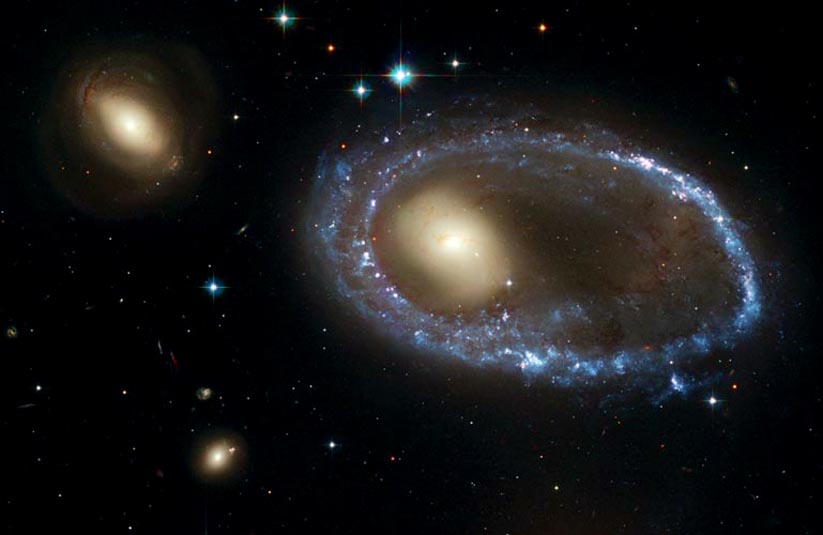
Ring Galaxy
R.A. 6h 43m 16s.59 Dec. -74° 14' 22".23
Volans
Approximately 300 million light-years (92 million parsecs)
This image is roughly 3 arcminutes (260,000 light-years or 81,000 parsecs) wide.
ACS/WFC
January 16/17, 2004
2.8 hours
NASA, ESA, and The Hubble Heritage Team (STScI/AURA)
April 22, 2004
ABOUT THIS IMAGE:
Resembling a diamond-encrusted bracelet, a ring of brilliant blue star clusters wraps around the yellowish nucleus of what was once a normal spiral galaxy in this new image from NASA's Hubble Space Telescope. This image is being released to commemorate the 14th anniversary of Hubble's launch on April 24, 1990 and its deployment from the space shuttle Discovery on April 25, 1990.
The sparkling blue ring is 150,000 light-years in diameter, making it larger than our entire home galaxy, the Milky Way. The galaxy, cataloged as AM 0644-741, is a member of the class of so-called "ring galaxies." It lies 300 million light-years away in the direction of the southern constellation Volans.
Ring galaxies are an especially striking example of how collisions between galaxies can dramatically change their structure, while also triggering the formation of new stars. They arise from a particular type of collision, in which one galaxy (the "intruder") plunges directly through the disk of another one (the "target"). In the case of AM 0644-741, the galaxy that pierced through the ring galaxy is out of the image but visible in larger-field images. The soft spiral galaxy that is visible to the left of the ring galaxy in the image is a coincidental background galaxy that is not interacting with the ring.
The resulting gravitational shock imparted due to the collision drastically changes the orbits of stars and gas in the target galaxy's disk, causing them to rush outward, somewhat like ripples in a pond after a large rock has been thrown in. As the ring plows outward into its surroundings, gas clouds collide and are compressed. The clouds can then contract under their own gravity, collapse, and form an abundance of new stars.
The rampant star formation explains why the ring is so blue: It is continuously forming massive, young, hot stars, which are blue in color. Another sign of robust star formation is the pink regions along the ring. These are rarefied clouds of glowing hydrogen gas, fluorescing because of the strong ultraviolet light from the newly formed massive stars.
Anyone who lives on planets embedded in the ring would be treated to a view of a brilliant band of blue stars arching across the heavens. The view would be relatively short-lived because theoretical studies indicate that the blue ring will not continue to expand forever. After about 300 million years, it will reach a maximum radius, and then begin to disintegrate.
The
Hubble Heritage Team used the Hubble Advanced Camera for Surveys to take
this image in January 2004. The team used a combination of four separate
filters that isolate blue, green, red, and near-infrared light to create
the color image.